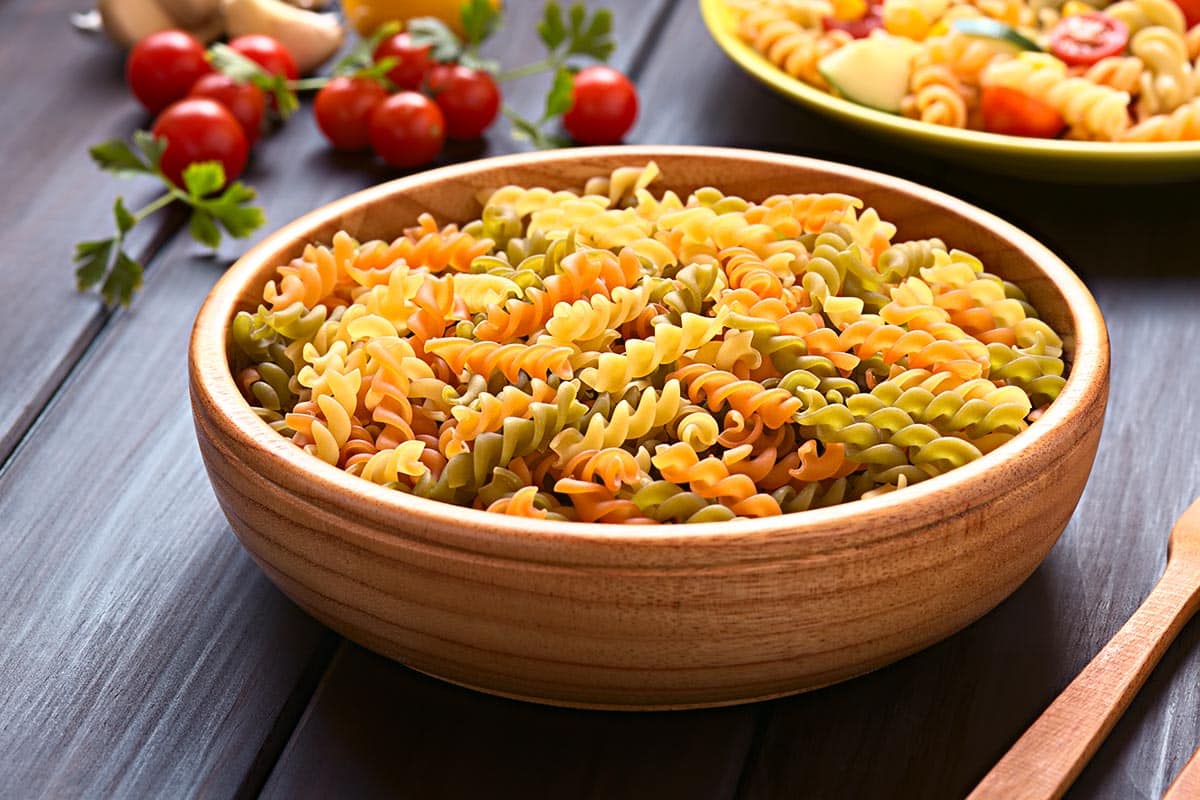Can’t decide between fusilli vs. rotini for your next pasta dish? It’s understandable since both of these types of pasta look almost identical. If you look at each type closely, you’ll see subtle differences.
This food guide will discuss all there is to know about these kinds of pasta. We’ll tell you how each got their name, what they look like, how to use them in recipes, and if their differences will affect the overall appearance of your dish.

You pronounce this pasta’s name as /foo-ZEE-lee/. This word fusilli comes from the word “fuso,” which translates to “spindle.” Like most kinds of pasta, fusilli is typically made from semolina flour. There are whole-wheat varieties too.
Fusilli is a thick and short Italian pasta. Each pasta piece looks like a spring with tight coils.
To make them, pasta makers roll the dough and then wrap or spin it around a spindle or a rod. Doing this gives fusilli its signature curly shape.
This pasta-making process might sound complicated. But fusilli is actually one of the pasta types you can make without using an extruder.
Fusilli is often light brown or off-white, like other pasta such as spaghetti and linguine. Some manufacturers sell it in different colors, like red and green.
Pasta makers also dye the red pasta pieces with either tomato juice or beets. The green ones have spinach juice that gives them their color.
There are different fusilli pasta variations. This pasta can either be solid or hollow, and it can also have loose or tight curls. Regular fusilli is solid, spun around a small rod to form a spring-like shape.
Fusilli bucati corti is a hollow pasta strand with a similar spring shape cut into short pieces. This variation usually has tight coils as well.
On the other hand, fusilli bucati lunghi are long and hollow strands that have a corkscrew shape. When cooked, they look like thick but hollow and loosely-curled spaghetti.
These variations usually have the same ingredients, so they taste the same.
Fusilli pasta is a multipurpose pasta. Cook it in boiling water until it’s “al dente”; then, you can save cooked pasta and use it in many recipes. Its curly shape traps thick sauces, including olive oil sauces, carbonara sauce, and creamy sauces.
They’re great with tomato sauce or in a pasta salad recipe. Plus, fusilli also makes a good pasta choice for soups.
You can add either dried or fresh fusilli pasta to a casserole recipe, too.
Rotini, pronounced as /ro-TEE-nee/, is a popular pasta in the US. The word “rotini” is Italian for “spirals.”
Like fusilli and other pasta varieties, rotini is usually made from semolina. Some variations use whole wheat flour, as well.
As the Italian translation of its name suggests, rotini has a twisted, spiral shape. When looking at uncooked pasta, some compare its shape to a more tightly wound corkscrew.
Rotini also comes in a tri-color mixed pasta version.
Like fusilli, the green rotini gets its color from spinach juice. The red rotini uses either beets or tomato juice, too.
Aside from red and green, there is also black rotini. The black version uses cuttlefish ink as a dye or black soybeans as an ingredient.
The spiral and grooved shape of rotini make it an extra versatile pasta. It works with thick and heavy sauces, as the curves trap the sauce and evenly distribute it.
Rotini pairs well with chunky and thicker sauces, as meat, cheese, and even nuts in the sauce tend to sit in its grooves.
This pasta is also perfect for cream, oil, and classic tomato-based sauces. The pretty shape of rotini makes it a popular choice for pasta salads, too.
Its versatility also allows you to add rotini to baked dishes.
The shapes of rotini vs fusilli make it confusing for people to tell them apart. To add fuel to the fire, some brands even label rotini as fusilli and vice-versa.
The easiest way to tell between fusilli vs rotini pasta is to look closely. Observe the shape of the pasta.
Fusilli starts as a solid or hollow strand of pasta that is later spun into a spring shape through a small rod. Meanwhile, the rotini is already in its distinct shape right after extrusion. Just look at this satisfying clip, and see for yourself.
When it comes to taste, fusilli has more of an al dente bite, with a hint of sweetness that pairs nicely with cream-based sauces. Rotini offers a delicate crunch that is perfect for heavier tomato sauces or bold ingredients like olives and capers.
Regarding cooking time, fusilli cooks faster than rotini because of its thicker shape. Rotini takes slightly longer to cook due to its wider circumference and more delicate nature.

There are over a hundred, if not a thousand, other pasta types according to shape.
Here are a few popular pasta types:
Gemelli translates to “twins.” This pasta is a great substitute for either fusilli or rotini because of its features. Gemelli looks like two intertwined pasta strands that resemble a spiral shape. But it is a twisted S-shaped pasta, and its crevices also work well in trapping sauces.
Another spiral-shaped pasta is radiatore, also called radiatori. This type of pasta is small and has ruffled, wavy lines. They resemble old-fashioned car radiators, hence the name. Its ridges work like the grooves of rotini, great at holding chunks of food from thick sauces.
Rotelle means “little wheels” or “small wheels”; true enough, they look like wagon wheels. The spokes on these wheels effectively trap sauces as fusilli and rotini do. Their interesting shape makes them great choices for decorative purposes.
Penne is the Italian word for “quill.” True to its name, penne pasta is a tube cut at an angle with pointed ends that look like a quill. This pasta’s hollow insides enable it to hold pasta sauce well.
You can store dry rotini in an airtight container or a sealed bag at room temperature for up to two years. To extend the shelf-life of your rotini, consider storing it in a cool, dark place like a pantry or kitchen cabinet.
You can also freeze cooked pasta for up to three months. To freeze, cook fresh pasta until just al dente and let it cool completely before transferring it to an airtight container or freezer bag. Make sure to squeeze out excess air from the bag or container before freezing. When ready to use, thaw in your refrigerator overnight or reheat in boiling water or a hot skillet.
To store cooked pasta, transfer it to an airtight container and refrigerate for up to three days. Reheat in a saucepan on the stovetop with a bit of extra moisture (like some pasta sauce or butter).
Fusilli and rotini are different; some brands label them interchangeably. Pasta makers readily extrude rotini in their twisted shape. Meanwhile, the fusilli starts as a straight strand, wound up in a rod to create a spring-like shape.
The size of both these pasta depends on the manufacturers. Both fusilli and rotini can vary in length and width, especially when they’re handmade. In most store-bought versions, though, fusilli is slightly longer than rotini.
Yes, you can substitute rotini for fusilli. These pasta shapes have crevices that capture tiny bits of meat or cheese in the sauce. That said, you can use them interchangeably and produce almost identical dishes.
Fusilli is a versatile pasta that goes well with thick and chunky sauces. This pasta also pairs well with pesto. The grooves of fusilli hold pieces of meat in chunky sauces. Similarly, bits of basil leaves in pesto get trapped there too. These characteristics give you the best eating experience.
Have you decided to use fusilli vs rotini? Do you have your preference? The thing is, these two kinds of pasta are different. But you can use fusilli in place of rotini and vice-versa. Their only difference is that rotini is already extruded in its actual shape. Meanwhile, fusilli need further processing to get to their spring-like form.
And, when substituting, the only consideration you should have is their ingredients. Using whole-wheat fusilli instead of regular rotini might result in a flavor change. But if you use regular rotini to replace regular fusilli, there will be no significant change.





